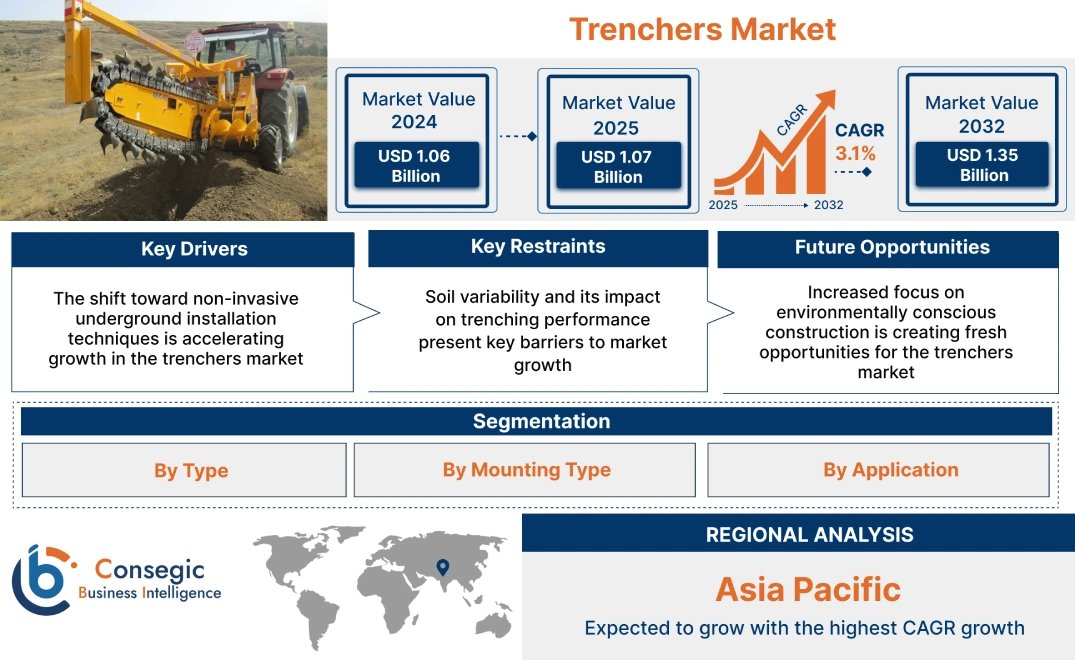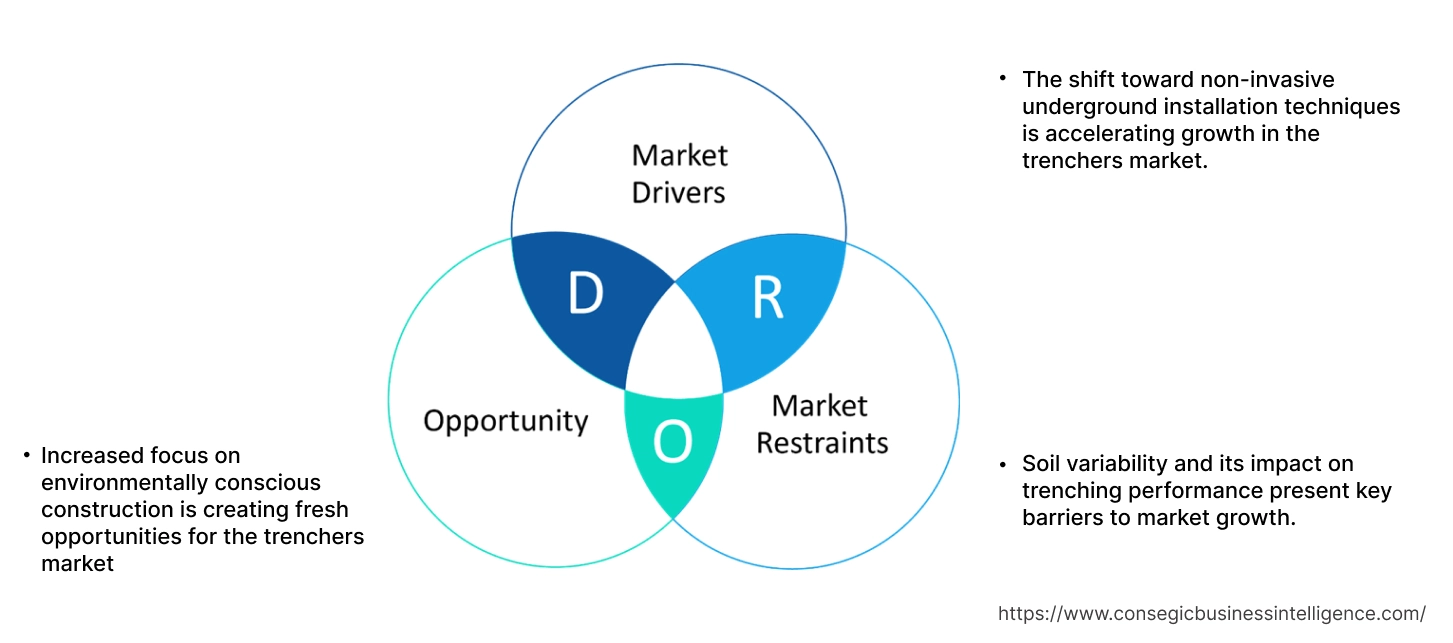- Summary
- Table Of Content
- Methodology
Trenchers Market Size:
Trenchers Market size is estimated to reach over USD 1.35 Billion by 2032 from a value of USD 1.06 Billion in 2024 and is projected to grow by USD 1.07 Billion in 2025, growing at a CAGR of 3.1% from 2025 to 2032.
Trenchers Market Scope & Overview:
Trenchers, also known as ditchers, are specialized construction machines used for digging narrow, straight excavations in soil or rock to install pipelines, cables, drainage, or foundation structures. These machines are designed with cutting mechanisms such as chains, wheels, or micro trenching attachments that operate with precision to produce uniform trench profiles with controlled depth and width. They are used in both utility and civil infrastructure projects, where defined excavation paths are required.
Configurations vary by application and include ride-on, walk-behind, and attachment-based units compatible with skid steers or compact track loaders. Cutting components are selected based on soil type, trench depth, and required trench width. Ditchers may also feature spoil removal systems, laser grading controls, and hydraulic depth adjustments to maintain trenching consistency across varying terrain. Their design often emphasizes mobility, operator visibility, and safe operation near underground assets.
End-users include contractors involved in pipeline installation, fiber optic deployment, landscaping, and irrigation system development. Ditchers support efficient linear excavation while minimizing backfill volume and surface disruption compared to conventional methods.
Key Drivers:
The shift toward non-invasive underground installation techniques is accelerating growth in the trenchers market.
Trenchless technology offers the ability to install underground utilities with minimal disruption to the surface. This technology eliminates the need for large, open trenches, which reduces the environmental impact, lowers labor costs, and speeds up the installation process. Ditchers play a vital role in preparing the ground for trenchless methods. These machines are essential for clearing soil and ensuring the accuracy of trench dimensions before trenchless equipment is used for installation. The increasing adoption of trenchless solutions facilitates for ditchers to be required more frequently to create the right conditions for these technologies to function effectively.
- For instance, Simex offers an expanded lineup to over 15 models of wheel saws tailored for mini and micro trenching applications, offering high-precision solutions for fiber optic, electrical, and irrigation installations. These attachments are designed for compact machines and are ideal for use in trenchless technology operations where minimizing surface disruption is critical.
As industries and municipalities shift towards trenchless systems for utility installation, the demand for trenching equipment that can handle these preparatory tasks is rising, significantly propelling market progress.
Key Restraints:
Soil variability and its impact on trenching performance present key barriers to market growth.
Trenchers are designed to work on different soils, but extreme or inconsistent soil conditions still present significant hurdles. In areas with rocky, clay-heavy, or uneven terrain, ditchers may struggle to perform effectively, leading to inefficiencies and potential equipment breakdowns. For instance, hard soils or large rocks may prevent the trenching machinery from cutting through efficiently, requiring constant adjustments or even downtime. These conditions also complicate the operation of the equipment, as farmers or construction companies must spend extra time recalibrating machinery settings. In certain areas where soil types vary drastically, this can slow down construction projects and increase costs. For businesses in regions where soil conditions fluctuate, these operational hurdles can make the adoption of ditchers less appealing, limiting the market's growth potential.
Future Opportunities :
Increased focus on environmentally conscious construction is creating fresh opportunities for the trenchers market.
Sustainability is becoming a central focus in the construction industry, driving the demand for eco-friendly and efficient solutions. With governments and corporations prioritizing in reducing their environmental footprint, the need for equipment that supports green building practices is growing. Ditchers equipped with energy-efficient engines, low emissions, and features designed to minimize soil disruption are well-positioned to meet these demands. These machines help reduce fuel consumption and lower carbon emissions compared to traditional methods of excavation. Additionally, trenchers that minimize surface disruption support sustainable land use by preserving the ecosystem and reducing the need for extensive land clearing.
- For instance, in March 2023, Helix Robotics Solutions, a division of Helix Energy Solutions Group, secured a significant trenching services contract for a 640 MW offshore wind farm project in Taiwan. The contract involves the trenching of inter-array and export cables, essential components for the wind farm's infrastructure. To execute this project, Helix plans to deploy its newly acquired T1400-1 jet trenching system, mobilizing it from Singapore aboard the Siem Topaz vessel. This initiative underscores Helix's strategic contract into the Asia-Pacific renewable energy sector and its role in the development of sustainable energy infrastructure.
As regulations around environmental impact become stricter, there are avenues for manufacturers to develop and market ditchers that align with these sustainability goals, significantly propelling trenchers market opportunities.
Trenchers Market Segmental Analysis :
By Type:
Based on Type, the market is segmented into Wheel Type, Chain Type, Micro Type, and Portable type.
The Chain Type segment holds the largest revenue of the overall Trenchers Market share of 42.5% in the year 2024.
- Chain trenchers are widely used for digging deep and narrow trenches, particularly in utility installation, sewer networks, and pipeline development.
- Their versatility and ability to operate in hard ground conditions make them the preferred choice for large infrastructure projects.
- Rental and construction companies invest in chain ditchers for long-term use in highway extension and pipeline routing across uneven terrain.
- According to the trenchers market analysis, their widespread application in civil, energy, and municipal projects, chain ditchers largely contributes to the market share, fueling the trenchers market expansion.
The Micro Type segment is expected to grow at the fastest CAGR during the forecast period.
- Micro trenchers are gaining rapid adoption in urban fiber optic deployment due to their ability to cut narrow, shallow trenches in asphalt and concrete.
- These compact machines minimize road disruption, reduce restoration costs, and comply with city planning regulations.
- Telecom companies and broadband providers are increasingly using micro ditchers to expand 5G and fiber-to-home (FTTH) networks.
- As per the market analysis, the growing investments in smart city infrastructure and digital connectivity fuel the global trenchers market growth.
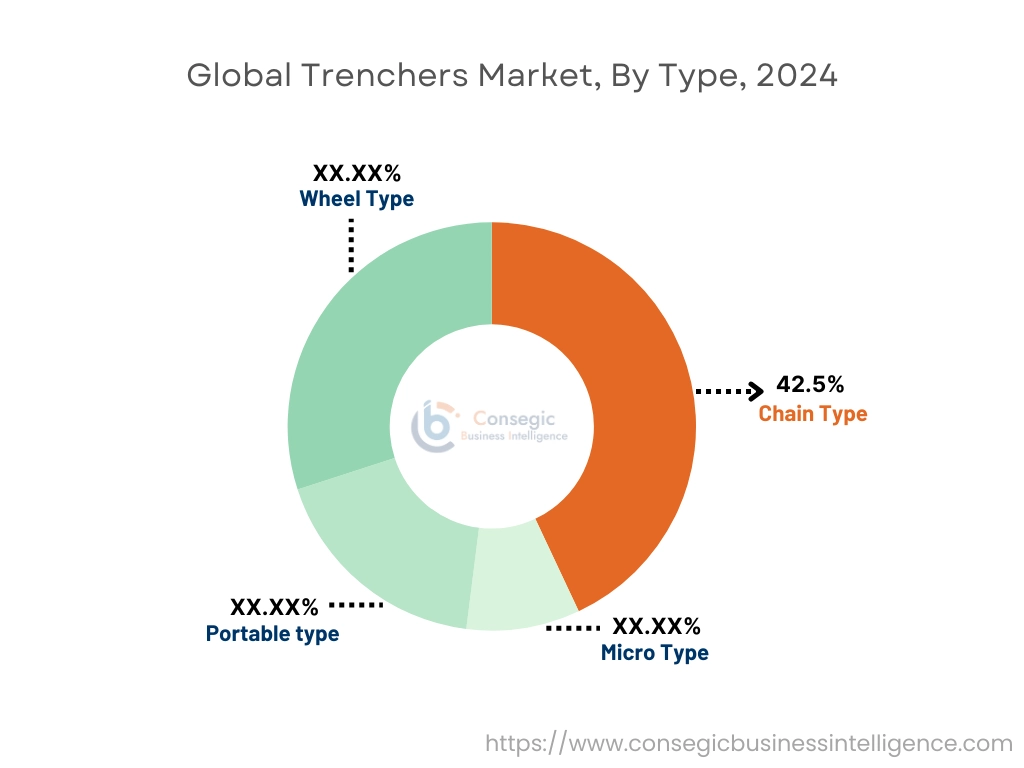
By Mounting Type:
Based on Mounting Type, the market is segmented into Walk-Behind, Ride-On, and Attachment-Based.
The Ride-On segment holds the largest revenue of the overall Trenchers Market share in the year 2024.
- Ride-on trenchers are widely deployed in medium to large-scale utility and infrastructure projects due to their capability to dig deeper and wider trenches across longer distances.
- These units offer improved operator comfort, greater engine power, and consistent trench depth control, making them suitable for high-volume applications such as pipeline laying and cable installation.
- Ride-on models are available with track or wheel configurations and can be outfitted with interchangeable booms or chains for customized digging operations.
- According to the trenchers market analysis, the widespread use across municipal, energy, and commercial construction segments, significantly fuels the market growth.
The Attachment-Based segment is expected to grow at the fastest CAGR during the forecast period.
- Attachment-based ditchers can be mounted on skid-steer loaders, compact track loaders, and tractors, offering flexible trenching capabilities without the need to purchase dedicated machines.
- These ditchers are gaining popularity among small-to-mid-scale contractors and landscapers seeking cost-effective, multipurpose equipment solutions.
- Manufacturers are introducing hydraulic and PTO-driven trenching attachments with quick-connect features for fast deployment and field versatility.
- The growing focus on lowering ownership cost and enhancing fleet utility have substantially driven the global trenchers market demand.
By Application:
Based on Application, the market is categorized into Agricultural Trenching, Oil and Gas Pipeline Installation, Energy Cables and Fiber Optic Laying, Telecommunication Networks Construction, Sewers and Water Pipelines Installation, and Others.
The Sewers and Water Pipelines Installation segment holds the largest revenue share of the overall Trenchers Market in the year 2024.
- Sewer and water pipeline installation projects account for a major portion of global trenching activity, particularly in urban infrastructure and public utility development.
- Municipalities and civil contractors rely on chain and ride-on ditchers for consistent trench depth, straight alignment, and minimized soil disruption.
- Ditchers support efficient installation of stormwater drainage systems, sanitation networks, and drinking water supply pipelines.
- Thus, the recurring public works programs and widespread municipal utility expansion is significantly driving the global trenchers market trends.
The Telecommunication Networks Construction segment is expected to grow at the fastest CAGR during the forecast period.
- Telecom providers deploy ditchers for laying copper and fiber optic cables in both urban and rural areas, including remote base stations and cell towers.
- Micro ditchers are preferred for minimal disruption in high-traffic roads and commercial neighborhoods, allowing fast and efficient cable deployment.
- Contractors increasingly use trenching robots and telematics-enabled equipment for real-time site updates and utility conflict detection.
- According to the market analysis, the evolving telecom infrastructure towards edge networks and smart city integration is significantly fueling the global trenchers market expansion.
Regional Analysis:
The regions covered are North America, Europe, Asia Pacific, Middle East and Africa, and Latin America.
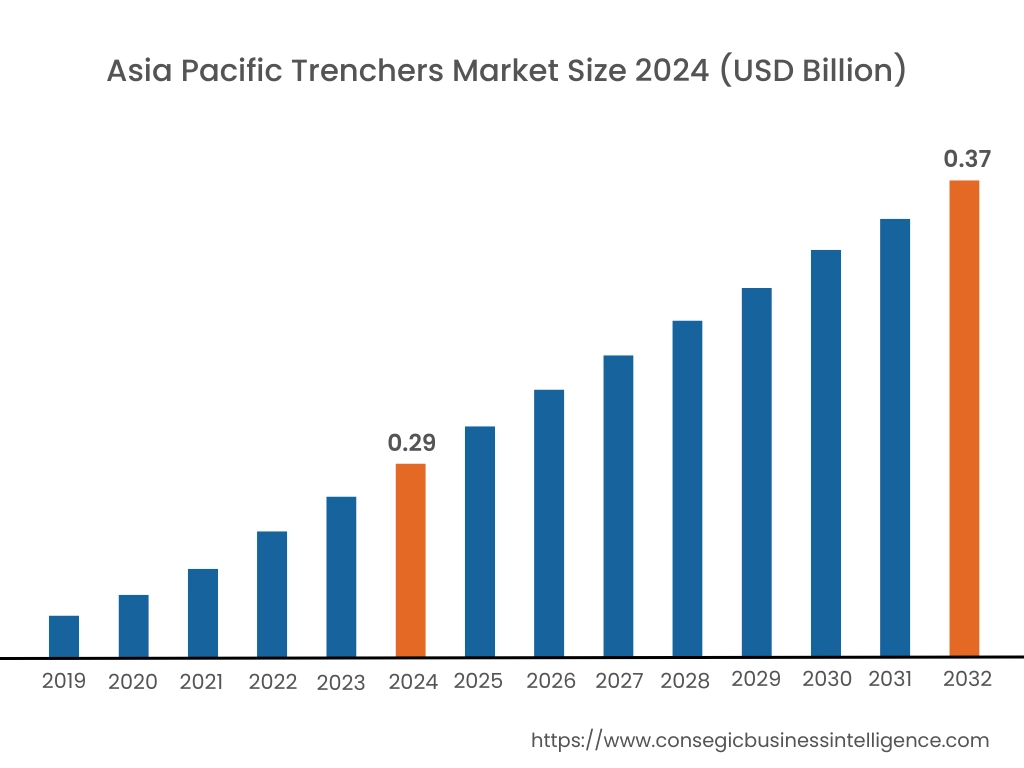
Asia Pacific region was valued at USD 0.29 Billion in 2024. Moreover, it is projected to grow by USD 0.29 Billion in 2025 and reach over USD 0.37 Billion by 2032. Out of this, China accounted for the maximum revenue share of 55.5%.
Asia-Pacific construction corridors are embracing ditchers equipped with AI-assisted obstacle detection and variable-depth control features. The increasing integration in infrastructure and agricultural initiatives have driven significant market growth. One notable trend sees robotic ditchers with obstacle-detection sensors deployed along China’s urban utility corridors, while another trend focuses on hybrid-powered models for India’s rural irrigation channels. Additionally, analysis of the market showed that Japan’s precision infrastructure maintenance programs while Australia’s mining site trench needs spur advanced machine uptake, and South Korea’s nationwide broadband trenching drives demand for automated, high-accuracy trenching systems, substantially driving the trenchers market demand.
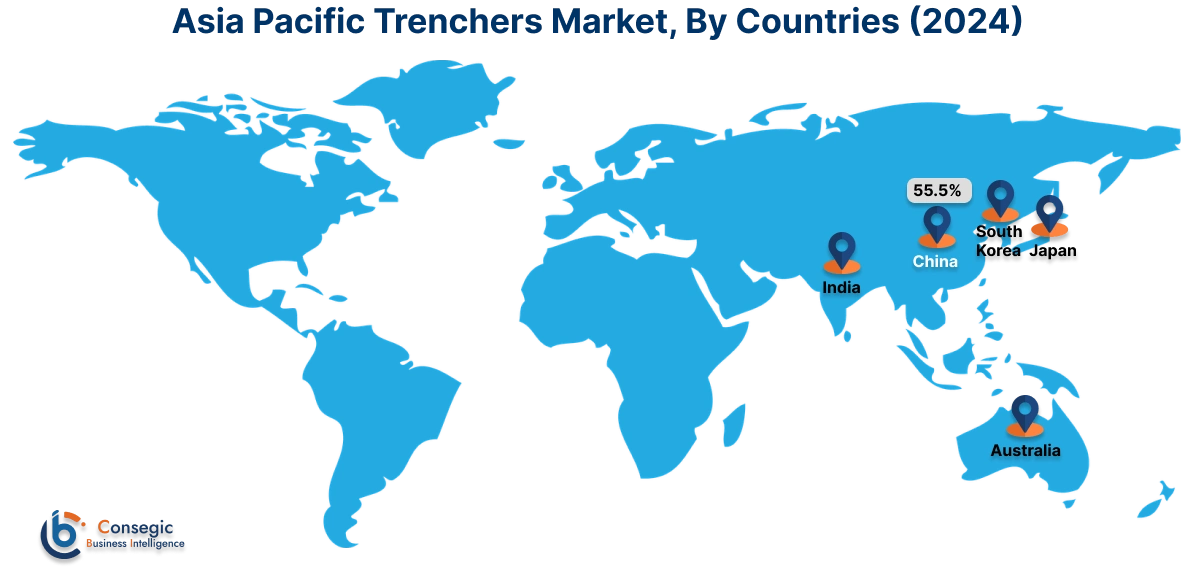
North America is estimated to reach over USD 0.45 Billion by 2032 from a value of USD 0.35 Billion in 2024 and is projected to grow by USD 0.36 Billion in 2025.
North American operations in the trenchers market are being reshaped by digital integration across utility and pipeline projects. A key trend involves the incorporation of advanced remote-control systems into heavy-duty ditchers and the modular conveyor attachments that optimize spoil handling on diverse job sites have boosted market growth. Additionally, the U.S. broadband extension initiatives and Canada’s rural utility upgrades drive adoption of these precision machines.
- For instance, Mastenbroek Limited introduced their largest-ever trencher, the 1600 trencher in the United States, marking a major milestone in the company’s development into North America. This high-performance machine is designed for large-scale pipeline and utility installation projects, offering impressive digging depth, efficiency, and reliability. The 1600 trencher is equipped with advanced automation and control systems, ensuring precise trenching while minimizing operator workload.
Furthermore, analysis of the market showed that utility network upgrade initiatives and rental service deployment and partnerships between manufacturers and service contractors are honing customization for varied soil conditions are significantly driving the Trenchers industry in this region.
European projects are aligning with sustainability mandates and infrastructure revitalization efforts. Embedding telematics for real-time performance monitoring on public works schemes and the enhanced emission-control hydraulics designed to comply with stricter standards drive demand for the market. Additionally, the shifting trend towards telematics-enabled units for Germany’s gas pipeline modernizations and low-emission hydraulics for France’s municipal utility works have propelled market development. Analysis of the market showed that government incentives for rehabilitation projects are propelling the uptake of these specialized ditchers, significantly boost the trenchers market in this region.
Across the Middle East and Africa, trencher operations adapt to challenging terrains and resource constraints. The corrosion-resistant cutter chains for UAE’s desert pipeline installations and the solar-assisted auxiliary systems supporting Saudi oil-field trenching leverage industry trends. Analysis of the market showed that urban megaprojects and mining sector upgrades underpin advanced equipment adoption, fueling the trenchers market in this region.
Latin American infrastructure and agricultural trench projects are leveraging ditchers with GPS-guided excavation and ergonomic operator cabins. One trend stresses multipurpose attachments for utility, irrigation, and rail maintenance tasks, while another trend highlights flexible leasing frameworks that offer short-term equipment access. In countries like Brazil, Argentina, Mexico, and Chile, ditchers’ requirements have soared to support agribusiness, utilities, and mining operations, substantially driving trenchers market growth in this region.
Top Key Players and Market Share Insights:
The Trenchers Market is highly competitive with major players providing products and services to the national and international markets. Key players are adopting several strategies in research and development (R&D), product innovation, and end-user launches to hold a strong position in the global Trenchers Market. Key players in the Trenchers industry include -
- Ditch Witch (USA)
- Vermeer Corporation (USA)
- The Toro Company (USA)
- Simex S.r.l. (Italy)
- Guntert & Zimmerman Const. Div., Inc. (USA)
- Trencor (USA)
- Tesmec S.p.A. (Italy)
- Marais Groupe (France)
- Mastenbroek Ltd. (UK)
- Wolfe Heavy Equipment (Canada)
Recent Industry Developments :
Product Launches:
- In February 2025, Barreto Manufacturing reveiled four new products in their product lineup. They presented the 30RTK Track Trencher, a powerful and compact machine built for efficiency, durability, and ease of use in demanding trenching applications. Designed with a track-driven system for enhanced traction and stability, the 30RTK is ideal for working in tough terrains and confined job sites. It features a pivoting track design that maintains consistent ground contact and a hydraulically operated boom for adjustable trench depth.
Trenchers Market Report Insights:
| Report Attributes | Report Details |
| Study Timeline | 2019-2032 |
| Market Size in 2032 | USD 1.35 Billion |
| CAGR (2025-2032) | 3.1% |
| By Type |
|
| By Mounting Type |
|
| By Application |
|
| By Region |
|
| Key Players |
|
| North America | U.S. Canada Mexico |
| Europe | U.K. Germany France Spain Italy Russia Benelux Rest of Europe |
| APAC | China South Korea Japan India Australia ASEAN Rest of Asia-Pacific |
| Middle East and Africa | GCC Turkey South Africa Rest of MEA |
| LATAM | Brazil Argentina Chile Rest of LATAM |
| Report Coverage |
|
Key Questions Answered in the Report
How big is the Trenchers Market? +
Trenchers Market size is estimated to reach over USD 1.35 Billion by 2032 from a value of USD 1.06 Billion in 2024 and is projected to grow by USD 1.07 Billion in 2025, growing at a CAGR of 3.1% from 2025 to 2032.
What specific segments are covered in the Trenchers Market? +
The Trenchers Market specific segments for Type, Mounting Type, Application, and Region.
Which is the fastest-growing region in the Trenchers Market? +
Asia pacific is the fastest growing region in the Trenchers Market.
What are the major players in the Trenchers Market? +
The key players in the Trenchers Market are Ditch Witch (USA), Vermeer Corporation (USA), The Toro Company (USA), Trencor (USA), Tesmec S.p.A. (Italy), Marais Groupe (France), Mastenbroek Ltd. (UK), Wolfe Heavy Equipment (Canada), Simex S.r.l. (Italy), Guntert & Zimmerman Const. Div., Inc. (USA), and others.
